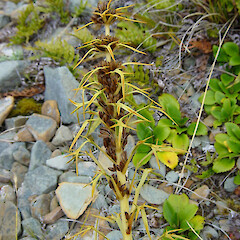Aciphylla hookeri
Family
Apiaceae
Flora category
Vascular – Native
Endemic taxon
Yes
Endemic genus
No
Endemic family
No
Structural class
Herbs - Dicotyledons other than Composites
NVS code
The National Vegetation Survey (NVS) Databank is a physical archive and electronic databank containing records of over 94,000 vegetation survey plots - including data from over 19,000 permanent plots. NVS maintains a standard set of species code abbreviations that correspond to standard scientific plant names from the Ngä Tipu o Aotearoa - New Zealand Plants database.
ACIHOO
Current conservation status
The conservation status of all known New Zealand vascular plant taxa at the rank of species and below were reassessed in 2017 using the New Zealand Threat Classification System (NZTCS) – more information about this can be found on the NZTCS website. This report includes a statistical summary and brief notes on changes since 2012 and replaces all previous NZTCS lists for vascular plants.
Please note, threat classifications are often suggested by authors when publications fall between NZTCS assessment periods – an interim threat classification status has not been assessed by the NZTCS panel.
- Conservation status of New Zealand indigenous vascular plants, 2017 . 2018. Peter J. de Lange, Jeremy R. Rolfe, John W. Barkla, Shannel P. Courtney, Paul D. Champion, Leon R. Perrie, Sarah M. Beadel, Kerry A. Ford, Ilse Breitwieser, Ines Schönberger, Rowan Hindmarsh-Walls, Peter B. Heenan and Kate Ladley. Department of Conservation. Source: NZTCS and licensed by DOC for reuse under the Creative Commons Attribution 4.0 International licence.
2017 | Not Threatened | Qualifiers: DP
Previous conservation statuses
2012 | Not Threatened
2009 | Not Threatened
2004 | Not Threatened
Distribution
Endemic. South Island, North-west Nelson to Aurthur’s Pass mostly on western side.
Habitat
Low-alpine (900-1400 m.a.s.l.) uncommon, snow tussock-herbfield.
Detailed description
Tufted sparse-leaved herb up to 30 cm tall, stock usually simple, taproot stout. Leaves up to approximately 20 cm long, 2-1 pinnate. Sheath very thin, approximately 70 x 10 mm, narrowing gradually to apex; stipules approximately 10 mm long, simple or sometimes with accessory segments; petiole crenulate-serrulate, approximately 40 mm long; lower internodes rather distant. Primary pinnae up to 20 mm long, with 1-(2) pairs of pinnules; all segments keeled, grooved, pungent, giving a squarrose appearance. Flowering stems sometimes leafy below, stout, grooved, up to 30 cm long including narrow paniculate inflorescence approximately 150 mm long. Bracts usually many, leaflike, up to approximately 100 mm long; sheaths roughly 50 mm long; stipules up to 10 mm long, unequal, acicular; lamina pinnate, approximately 50 mm long, segments pungent. Umbels several, on 5-10 unequal slender rays less than bracts. Umbellules small, on short slender rays. Fruit approximately 4-5 mm long, mericarps with 3-5 wings.
Similar taxa
Aciphylla anomala is similar in habit, but differs by longer thicker petioles (80 x 2 mm) and leaflets (100 x 2.5 mm); flower bract stems have shorter stipules (5 mm).
Flowering
December – February (-March)
Fruiting
January – April
Life cycle
Winged schizocarps are dispersed primarily by wind (Thorsen et al., 2009).
Etymology
aciphylla: From the Latin acicula ‘needle’ and the Greek phyllum ‘leaf’, meaning needle-leaf.
hookeri: Named after Sir Joseph Dalton Hooker (born 1817) - a world famous botanist who travelled on the Antarctic expedition of 1839 under the command of Sir James Ross and wrote “Handbook of New Zealand Flora” published in 1864-67 describing many specimens sent to Kew by collectors. He died in 1911 and has a memorial stone at Westminster Abbey London.
TAXONOMIC NOTES
Dawson & LeComte suggest this species is part of the group with clear juice. They note it may also be seen to hybridise; A. hookeri x A. indurata seen at Mt. Bovis, reported by W. R. B. Oliver; A. hookeri x A. townsonii seen in the Lyell Range, reported J. W. Dawson (In the last case the probable hybrids were growing in large patches of granite boulders and were so varied that they must include back crosses).
Attribution
Description adapted by M. Ward from Allan (1961).
References and further reading
Allan, H. H. 1961. Flora of New Zealand. Vol. 1. Wellington: Government Printer. pg. 476-477.
Dawson, J.W. LeComte, J.R. 1978. Research on Aciphylla - a progress report. Tuatara 23: pg. 49-67.
Mark, A. F. 2012. Above the Treeline: A Nature Guide to Alpine New Zealand. Craig Potton Publishing, Nelson. pg. 148.
Thorsen, M. J.; Dickinson, K. J. M.; Seddon, P. J. 2009. Seed dispersal systems in the New Zealand flora. Perspectives in Plant Ecology, Evolution and Systematics 2009 Vol. 11 No. 4 pp. 285-309


